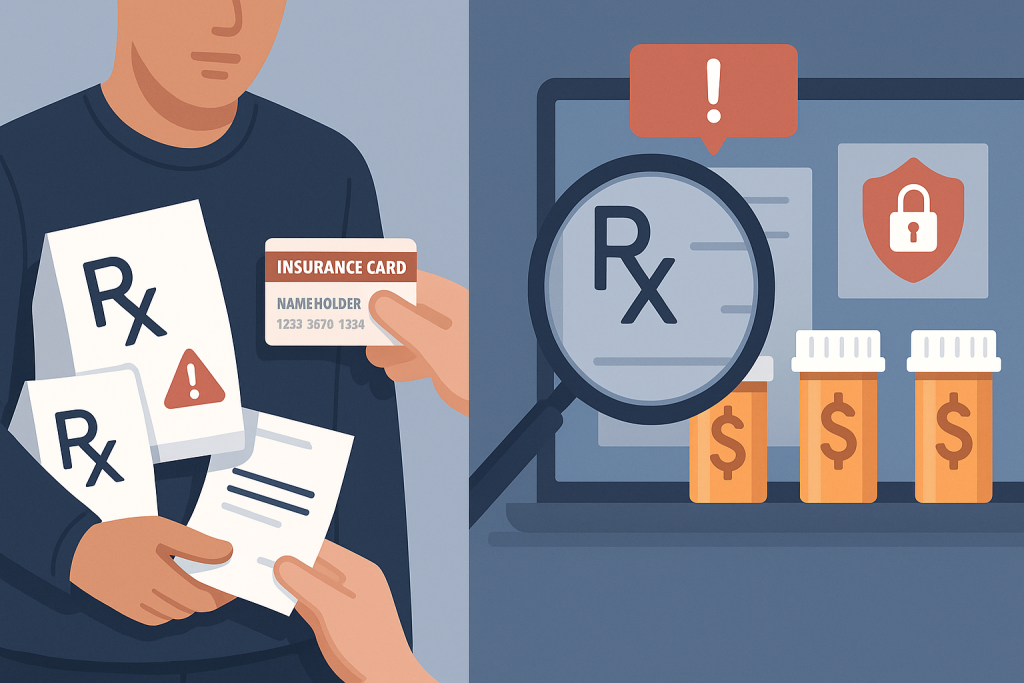
Most employees use their pharmacy benefit correctly, but a small group exploits loopholes. Their actions inflate drug spend, strain plan reserves, and jeopardize the fiduciary duty employers owe to every participant. Keep reading to learn how to identify and prevent patient-driven pharmacy fraud.
Spotting the Tactics
Prescription or doctor shopping is the classic red flag. A member visits several prescribers (primary care, urgent care clinics, and telehealth services) without disclosing prior fills. The goal is to obtain overlapping scripts for controlled substances, high-demand GLP-1s, or brand-name drugs that should have been substituted.
Pharmacy hopping follows the same playbook on the dispensing end. Instead of returning to the same network pharmacy, the member fills each claim at a different location and hopes no single pharmacist sees the refill pattern. Because claims adjudicate cleanly in real time, the abuse can continue until analytics catch it.
Card sharing and identity fraud surface when a friend or relative presents another member’s ID at the counter or online portal. Claims history no longer aligns with the true patient, which skews drug-to-drug interaction checks and safety edits.
Resale or diversion of high-cost therapies often involves hepatitis C antivirals, weight-loss injectables, or oncology support drugs. After shipment, the member sells unused doses through gray-market channels or returns them for cash. Plan dollars fund inventory that never benefits the covered population.
Manipulating prior authorization takes two forms. Some members look for prescribers known to write non-preferred brands on thin clinical justification. Others flood the appeals desk with emotional narratives rather than clinical evidence or push HR and leadership to override a denial. Both moves bypass the formulary’s intent and erode fairness for every participant.
Why It Matters

Prevention Playbook
- Real-time claims edits reject duplicate prescribers, early refills, or conflicting therapies and route exceptions to a clinical pharmacist the same day.
- Refill and quantity limits keep new starts on 30-day supplies and require partial fills for high-risk drugs until adherence and safety are confirmed.
- Lock-in programs assign confirmed abusers to one prescriber and one pharmacy. The written notice cites patient safety and fiduciary duty as the rationale.
- Hard PA stops with third-party review require an independent clinician to sign off before any override. Every approval is documented with medical evidence, not anecdotes.
- Pattern-recognition analytics flag members who visit multiple pharmacies or providers, repeatedly reversing or returning claims for high-cost specialty drugs, or sit in the top one percentile for spend. Quarterly reviews feed case management and compliance teams.
- Member and provider education puts PA rules and formulary logic front and center in welcome kits, open-enrollment webinars, and provider newsletters.
- Zero-tolerance language in the plan document states that benefit misuse triggers investigation and possible disciplinary action, including removal from coverage or legal escalation.
How to Identify and Prevent Patient-Driven Pharmacy Fraud
Fraud prevention is not about punishment; it is about stewardship. When plan administrators insist on accurate prescribing, transparent appeals, and data-driven oversight, everyone wins when costs drop, outcomes improve, and fiduciary risk shrinks. Put controls in place before misuse becomes newsworthy, communicate them often, and hold the line.
Elevate your expertise in pharmacy benefits management with the Certified Pharmacy Benefits Specialist® (CPBS) program, sponsored by the UNC-Chapel Hill Eshelman School of Pharmacy. Whether you’re an HR leader, finance executive, consultant, or pharmacist, this certification provides the in-depth knowledge and strategic insight needed to manage pharmacy benefits with confidence and cost efficiency. Gain up to twenty continuing education credits, enhance your career prospects, and help your organization take control of pharmacy spend. Register today to join a growing network of professionals shaping the future of pharmacy benefits management. Learn more at the Pharmacy Benefit Institute of America.
